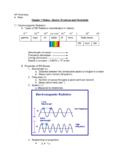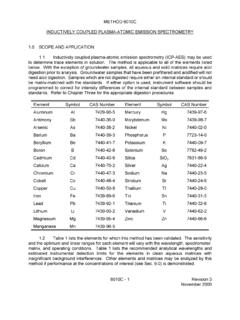Transcription of Noteson&Atomic&Structure& - TAPIR at Caltech
1 Notes on atomic Structure Friday, January 7, 2011 CONTENTS: 1. Introduction 2. Hydrogen Atoms and One- electron Ions A. Basic structure B. Radiative transitions C. Electron spin & fine structure D. Hyperfine structure 3. Helium Atoms and Two- electron Ions A. Description of multi- electron atoms B. Energy level structure C. Radiative transitions 4. The Light Metals A. One valence electron (Li, Na, K) B. Two valence electrons (Be, Mg) C. The p- block atoms (B F, Al Cl) 1. Introduction The study of the energy levels and transitions of atoms and one- atom ions is critical for understanding many features of the ISM: Spectra: Many of the strongest spectral lines from the ISM (both in UV/optical and FIR) are due to atoms and ions.
2 Thermal balance: Excitation of atoms, followed by radiative decay, is a major cooling mechanisms for many ISM phases. This lecture covers the energy level structure and radiative transition schemes of H, He, and the light metals. The transition metals are not covered due to their complexity, and also because most of the major lines we will be discussing are due to lighter elements, particularly C/N/O. The most abundant of the heavier metals is Fe, which we will discuss primarily in the context of dust (and in the case of X- ray processes where the inner electrons play a key role). 2. Hydrogen Atoms and One- Electron Ions The ultimate reference for this material is Bethe & Salpeter, Quantum Mechanics of One- and Two- Electron Atoms.
3 A. BASIC STRUCTURE Hydrogen is the simplest atom, consisting of a single electron and a nucleus. We will treat the hydrogenlike atoms generally, allowing for a nuclear charge Z. For example, Z=2 corresponds to the He+ (He II) ion, whereas Z=26 corresponds to Fe25+ (Fe XXVI). The atom can be treated by writing the Schr dinger equation for the single electron, with the potential V(r)= Ze2r, and the wave function can be separated in spherical coordinates as nlml(r, , )=Rnl(r)rYlml( , ), where Y is a spherical harmonic, R is the radial wave function, and nlml are quantum numbers. The angular quantum numbers are integers with l 0, |ml| l. Spherical symmetry guarantees that the different values of m have the same energy and the same radial wave function; this energy can be shown to be: Enl= Z2e4me2 2n2= ( eV)Z2n2, where the radial wave functions have quantum numbers n l.
4 We note that due to an accidental degeneracy the different values of l for the same n have the same energy. For a given value of (n,l) there are 2l+1 possible wave functions, and for a given value of n there are n2 wave functions (after including all legal values of l). To account for electron spin (up or down; ms= ), the number of states should be doubled to 2(2l+1) or 2n2. The ground state of H is n=1, which has only one wave function (and two spin states). The angular momentum number l is frequently denoted with a letter: s (l=0), p (l=1), d(l=2), f (l=3), g (l=4), etc. Thus the ground state is 1s. B. RADIATIVE TRANSITIONS Radiation can be emitted by an atom in an excited state with a frequency given by h =E E', where E is the energy of the upper level and E is that of the lower level.
5 For a hydrogenlike atom, the frequencies are then given by = eVhZ21n22 1n12 , where n2<n1 are positive integers. The transition wavelengths for the hydrogen atom are: Lyman series (n2=1) Paschen series (n2=3) Ly 2 1 1216 Pa 4 3 m Ly 3 1 1026 Pa 5 3 m Ly 4 1 973 Pa 6 3 m Ly 5 1 950 Pa 7 3 m Balmer series (n2=2) Brackett series (n2=4) H 3 2 6563 Br 5 4 m H 4 2 4861 Br 6 4 m H 5 2 4340 Br 7 4 m H 6 2 4102 Br 8 4 m In our studies, we will also want to know the rate of emission of photons (the radiative decay rates).
6 A correct calculation requires QED, but we may estimate the decay rate semi- classically. In classical physics (Ph 1c), the rate at which energy is emitted from an electric dipole of moment is: P=2 23c3=2 4 23c3. If we think of this power as being emitted in discrete units of energy , the rate of emission of photons (with units of counts per second) is =2 3 23 c3. For a given transition, we know =2 , but we do not yet know the dipole moment . We do know the expectation value of the dipole moment for a superposition of the initial and final states 1 and 2: (x)=c1 1(x)+c2 2(x), = ex= ec12 1x 1 ec22 2x 2 2eRec2*c1 2x 1(). Now we note that the initial and final wave functions have definite parity, that is, (x)= ( x).
7 In the case of hydrogen, the + parity applies to even l and the to odd l. The situation will be more complicated for heavier atoms, but the wave functions will still have definite parity ( when the coordinates of all electrons are sign- reversed, the overall wave function has a + or sign) since the parity operation commutes with the Hamiltonian. This implies that < 1|x| 1>=0, so only the overlap integral contributes to . Thus the classical emission rate is =8 3e23 c3 Rec2*c1 2x 1()[]2. Now we know from elementary quantum mechanics that cj exp(- iEjt/ ), so in the above the real part is oscillating as a function of time and the square of the real part averages to of the square of the absolute value.
8 One might guess that during a radiative transition, both c1 and c2 are of order unity. In fact, this argument is correct: the exact QED result is =4 3e23 c3 2x 12. In most practical cases, we are interested in the total decay rate to all m- sublevels of the final state. This decay rate is often called the Einstein A- coefficient and symbolized by A12: A12=4 3e23 c3 2,m2x 12m2= l2l2 . Note that transitions are only allowed if they flip parity (otherwise the matrix element is zero by symmetry). This is an example of a selection rule. For hydrogen, this means l2- l1 is odd. For the case of hydrogen, the A coefficients can be determined exactly. We separate the matrix element into radial and angular pieces: 2x 1=rRn2l2*(r)0 Rn1l1(r)dr n Yl2m2*( n )Yn1l1( n )d2 n S2.
9 The integral involving the spherical harmonic is only nonzero if l2- l1= 1 (the triangle inequality for angular momentum forbids larger changes; alternatively, write Ylm as a polynomial of order l in the Cartesian components of n and observe that nYlm is a polynomial of order l+1, hence must be composed exclusively of spherical harmonics of order l+1). This is a general rule. For the allowed transitions and small values of n, the matrix element is of order the Bohr radius (10 8 cm), the angular frequencies are of order 1016/s, and so we get decay rates of the order of 109/s (lifetimes ~ 1ns). This is indeed correct. Actual calculations give the following rates (in units of 109/s): 2p 1s 3s 2p 3p 1s 3p 2s 3d 2p 4s 2p 4s 3p 4p 1s 4p 2s 4p 3s 4p 3d 4d 2p 4d 3p 4f 3d For heavier atoms, the transition frequencies scale as Z2, the radii scale as 1/Z, and so the transition rates scale as Z4, they are 16 larger for He II than for H I.
10 One notable feature of the above is that the 2s level of hydrogen cannot decay: the only lower energy level is 1s, and the parity selection rule forbids this. The 2s level instead decays by two- photon decay: H(2s) H(1s) + + . The sum of the energies of the two emitted photons is E2s E1s = eV. The photons have a continuous spectrum since there is no other constraint on their energies. This is a major contributor to the UV/optical continuum from many nebulae. Quantum mechanically, this corresponds to emitting one photon and landing in an intermediate 2p state, and then emitting the second photon. The uncertainty principle allows the hydrogen atom to borrow the energy to emit the first photon, for a period of time of order t~ / E~10 16s.







